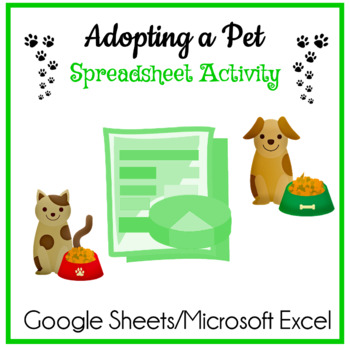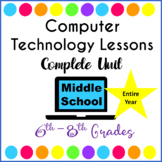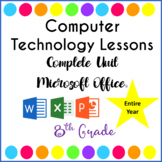Adopting a Pet Google Sheets & Charts/Microsoft Excel Spreadsheet Activity
- PDF
- Google Apps™
- Excel Spreadsheets

What educators are saying
Also included in
- An entire year of WEEKLY Computer Technology Lessons & Activities for 5th Grade. This bundle includes Computer Technology Lessons for Google Drive apps for a WEEKLY Computer Class or for classroom teachers wanting to teach Google Apps on a weekly basis.Each lesson/activity is approximately 35 miPrice $83.84Original Price $88.25Save $4.41
- An entire year of WEEKLY Computer Technology Lessons & Activities for Grades 6th - 8th. This bundle includes Computer Technology Lessons for Google Drive apps for a WEEKLY Computer Class or for classroom teachers wanting to teach Google Apps on a weekly basis.Each lesson/activity is approximatelPrice $327.69Original Price $344.94Save $17.25
- An entire year of WEEKLY Computer Technology Lessons & Activities for 8th Grade & Up. This bundle includes Computer Technology Lessons for Microsoft Office for a WEEKLY Computer Class or for classroom teachers wanting to teach Microsoft Office on a weekly basis.Each lesson/activity is approxPrice $147.91Original Price $156.19Save $8.28
Description
No PREP! This spreadsheet activity is for students already familiar with calculating in Google Sheets or Microsoft Excel. Students will reinforce their spreadsheet and chart skills when they choose a dog or cat to adopt and calculate the expenses using either Google Sheets or Microsoft Excel. Includes Student directions and colorful Cat and Dog Supplies sheets. Easy to assign digitally or print directions for students. Please Note: Students are expected to know how to add, multiply and create a basic pie chart as the directions are NOT step-by-step How-To but a guide. Includes an EDITABLE Google Sheets Answer Key. Downloads in Google Sheets and works perfectly in Microsoft Excel.
Updated Prices on 1/23/24
Uses: Computer Lab, Classrooms with 1:1 Devices, Distance Learning, Sub Activities
Technology Standards:
1.c Use technology to seek feedback that informs and improves their practice and to demonstrate their learning in a variety of ways.
3.d Build knowledge by actively exploring real-world issues and problems, developing ideas and theories and pursuing answers and solutions.
Pet Adoption Spreadsheet Activity Includes:
- Student Google Sheets Spreadsheet Link
- Student Directions PDF
- Cat & Dog Supplies PDF
- Editable Google Sheets Answer Key
Your Students might also Enjoy:







